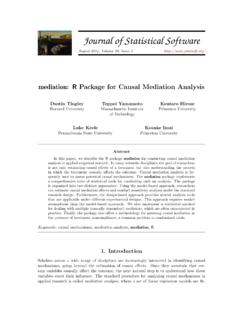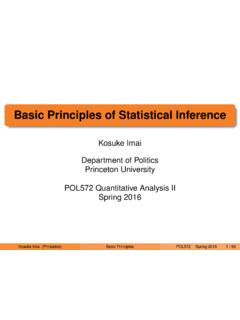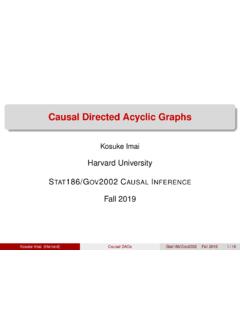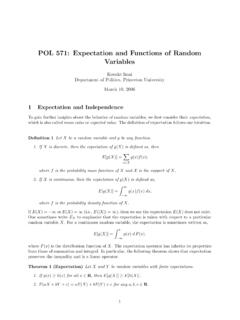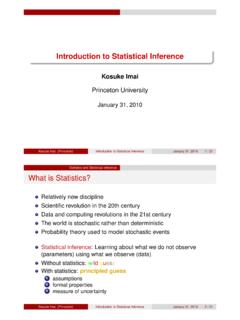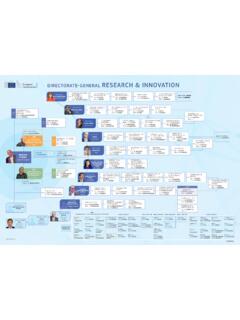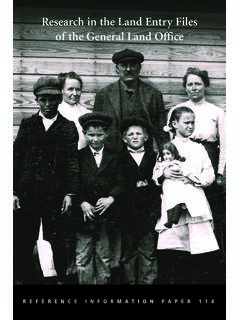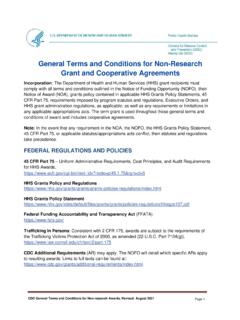Transcription of A General Approach to Causal Mediation Analysis
1 A General Approach to Causal Mediation AnalysisKosuke ImaiPrinceton UniversityLuke KeeleOhio State UniversityDustin TingleyHarvard UniversityTraditionally in the social sciences, Causal Mediation Analysis has been formulated, understood, andimplemented within the framework of linear structural equation models. We argue and demonstrate thatthis is problematic for 3 reasons: the lack of a General definition of Causal Mediation effects independentof a particular statistical model, the inability to specify the key identification assumption, and thedifficulty of extending the framework to nonlinear models. In this article, we propose an alternativeapproach that overcomes these limitations. Our Approach is General because it offers the definition,identification, estimation, and sensitivity Analysis of Causal Mediation effects without reference to anyspecific statistical model. Further, our Approach explicitly links these 4 elements closely together withina single framework.
2 As a result, the proposed framework can accommodate linear and nonlinearrelationships, parametric and nonparametric models, continuous and discrete mediators, and varioustypes of outcome variables. The General definition and identification result also allow us to developsensitivity Analysis in the context of commonly used models, which enables applied researchers toformally assess the robustness of their empirical conclusions to violations of the key assumption. Weillustrate our Approach by applying it to the Job Search Intervention Study. We also offer easy-to-usesoftware that implements all our proposed : Causal inference, Causal mechanisms, direct and indirect effects, linear structural equationmodels, sensitivity analysisCausal inference is a central goal of social science research . Inthis context, randomized experiments are typically seen as a goldstandard for the estimation of Causal effects, and a number ofstatistical methods have been developed to make adjustments formethodological problems in both experimental and observationalsettings.
3 However, one common criticism of experimentation andstatistics is that they can provide only a black-box view of cau-sality. The argument is that although the estimation of causaleffects allows researchers to examine whether a treatment causallyaffects an outcome, it cannot tell us how and why such an effectarises. This is an important limitation because the identification ofcausal mechanisms is required to test competing theoretical expla-nations of the same Causal effects. Causal Mediation Analysis playsan essential role in potentially overcoming this limitation by help-ing to identify intermediate variables (or mediators) that lie in thecausal pathway between the treatment and the , Causal Mediation Analysis has been formulated,understood, and implemented within the framework of linear struc-tural equation modeling (LSEM; , Baron & Kenny, 1986;Hyman, 1955; James, Mulaik, & Brett, 1982; Judd & Kenny, 1981;MacKinnon, 2008; MacKinnon & Dwyer, 1993).
4 We argue anddemonstrate that this is problematic for two reasons. First, byconstruction, the LSEM framework cannot offer a General defini-tion of Causal Mediation effects that are applicable beyond specificstatistical models. This is because the key identification assump-tion is stated in the context of a particular model, making itdifficult to separate the limitations of research design from those ofthe specific statistical , the methods developed inthe LSEM framework are not generalizable to nonlinear models,1By identification, we mean whether the Causal Mediation effects canbe consistently estimated. Thus, identification is a minimum requirementfor valid statistical inference and precedes the issue of statistical estima-tion, which is about how to make inferences from a finite sample. Seebelow for the formal discussion in the context of Causal Mediation analysisand Manski (2007) for a General article was published Online First October 18, Imai, Department of Politics, Princeton University; Luke Keele,Department of Political Science, Ohio State University; Dustin Tingley,Department of Government, Harvard for this study was supported in part by National ScienceFoundation Grant SES-0918968.
5 The two companion articles, one formingthe theoretical basis of this article and the other providing the details ofsoftware implementation of the proposed methods, are available as Imai,Keele, and Yamamoto (2010) and Imai et al. (2010a), respectively. Theeasy-to-use software, Mediation , is freely available at the Comprehensive RArchive Network ( ). Thereplication materials for all the empirical results presented in this article areavailable at the authors dataverse (Imai et al., 2010). We thank MattIncantalupo, Dave Kenny, Dave MacKinnon, Keith Markus, Scott Max-well, Walter Mebane, and Kris Preacher for useful comments that signif-icantly improved the presentation of this concerning this article should be addressed to KosukeImai, Department of Politics, Princeton University, Princeton, NJ : Methods2010, Vol. 15, No. 4, 309 334 2010 American Psychological Association1082-989X/10/$ DOI: logit and probit models, for discrete mediators andoutcomes as well as non- or semiparametric this article, we propose a General Approach that overcomesthese limitations.
6 We use a single framework for the definition,identification, estimation, and sensitivity Analysis of Causal medi-ation effects without reference to any specific statistical , following the recently published work ( , Jo, 2008; Sobel,2008), we place Causal Mediation Analysis within the counterfac-tual framework of Causal inference and offer the formal definitionof Causal Mediation effects. This definition formalizes, indepen-dent of any specific statistical models, the intuitive notion aboutmediation held by applied researchers that the treatment indirectlyinfluences the outcome through the , we slightly extend the result of Imai, Keele, andYamamoto (2010), who proved that under the sequential ignor-ability assumption the average Causal Mediation effects arenon-parametricallyidentified ( , can be consistently estimated with-out any functional form and distributional assumptions).Sequential ignorability consists of two assumptions: (a) Condi-tional on the observed pretreatment covariates, the treatment isindependent of all potential values of the outcome and mediatingvariables, and (b) the observed mediator is independent of allpotential outcomes given the observed treatment and pretreatmentcovariates.
7 Such a nonparametric identification Analysis is impor-tant because it establishes a minimum set of assumptions requiredfor Mediation effects to be interpreted as Causal without respect tostatistical models used by , using our nonparametric identification result, we developgeneral estimation procedures for Causal Mediation effects that canaccommodate linear and nonlinear relationships, parametric andnonparametric models, continuous and discrete mediators, andvarious types of outcome variables. In the literature, some haveextended the LSEM framework to these settings ( , Li, Schnei-der, & Bennett, 2007; MacKinnon, 2008; MacKinnon, Lockwood,Brown, Wang, & Hoffman, 2007; Wang & Taylor, 2002). Ourapproach encompasses many of the existing methods as specialcases, thereby accomplishing many of future statistical tasks iden-tified in a recent review article by MacKinnon and Fairchild(2009).The last and yet perhaps most important contribution of ourproposed Approach is a set of sensitivity analyses we develop forstatistical models commonly used by applied researchers.
8 Sensi-tivity Analysis allows researchers to formally quantify the robust-ness of their empirical conclusions to the potential violation ofsequential ignorability, which is the key and yet untestable as-sumption needed for identification. The fundamental difficulty inthe Causal Mediation Analysis is that there may exist unobservedconfounders that causally affect both the mediator and the outcomeeven after conditioning on the observed treatment and pretreatmentcovariates. Therefore, assessing the sensitivity of one s empiricalfindings to the possible existence of such confounders is requiredin order to evaluate the validity of any Mediation study. In theLSEM framework, Imai, Keele, and Yamamoto (2010) proposed astraightforward way to check how severe the violation of the keyidentifying assumption would need to be for the original conclu-sions to be reversed. We generalize this sensitivity Analysis so thatit can be applied to other our Approach is developed without any reference to aparticular statistical model, it is applicable across a wide range ofsituations.
9 In this article, we illustrate its applicability using avariety of cross-section settings. Our General Approach also al-lowed us to develop the easy-to-use software, Mediation , which isfreely available as an R package (R Development Core Team,2009) at the Comprehensive R Archive the analysespresented in this article are conducted with this software. Thedetails about the software implementation and its usage are givenin a companion article (Imai, Keele, Tingley, & Yamamoto,2010a). Future research should address the application of ourapproach to the panel data settings ( , Cole & Maxwell, 2003;MacKinnon, 2008, Chapter 8), and multiple ( , MacKinnon,2000; Preacher & Hayes, 2008) and multilevel ( , Krull &MacKinnon, 1999) mediators, all of which are beyond the scope ofthe current Running Example: The Job Search InterventionStudy (JOBS II)To motivate the concepts and methods that we present, we relyon an example from the psychology literature on Mediation anduse the JOBS II for our illustration.
10 JOBS II is a randomized fieldexperiment that investigates the efficacy of a job training interven-tion on unemployed workers. The program is designed not only toincrease reemployment among the unemployed but also to enhancethe mental health of the job seekers. In the experiment, 1,801unemployed workers received a prescreening questionnaire andwere then randomly assigned to treatment and control in the treatment group participated in job skills workshopsin which participants learned job search skills and coping strate-gies for dealing with setbacks in the job search process. Those inthe control condition received a booklet describing job search follow-up interviews, two key outcome variables were mea-sured: a continuous measure of depressive symptoms based on theHopkins Symptom Checklist and a binary variable, representingwhether the respondent had become who originally analyzed this experiment hypothe-sized that workshop attendance leads to better mental health andemployment outcomes by enhancing participants confidence intheir ability to search for a job (Vinokur, Price, & Schul, 1995;Vinokur & Schul, 1997).
